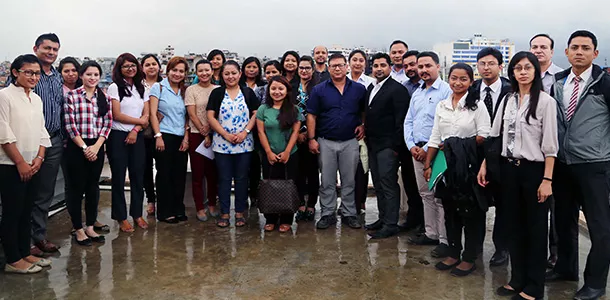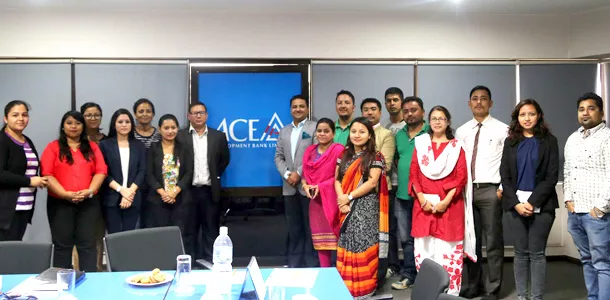
69th HR Kurakani interacts on Workplace Recognition
Category: HR Kurakani | Date: June 27, 2017, 12:15 p.m. | Total Views: 2910
The 69th HR Kurakani was held on the 27th of June at the office of Real Solutions, in Minbhawan, New Baneshwor. HR Kurakani is a platform organised by Real Solutions to discuss specific topics within the Human Resource domain, with the aim of improving Human Resource Management in Nepal. It is held periodically once every month, specifically the last Wednesday of the month, in the English calendar.
For the 69th edition of HR Kurakani, the primary topic in focus was “Reward and Recognition for motivation in the workplace”. The event began with a formal introduction of all the participating members, and a short welcoming and introductory address by the presiding moderator, Miss Nibha Shakya – HR head of Real Solutions. The participants at the discourse consisted of HR executives from a very diverse range of industries such as IT, construction, finance, hospitality and more.
What is Reward and What is Recognition?
To begin with, the participants first sought to explain the concept of reward and recognition in a practical sense. While there are numerous definitions on the internet that theoretically explain what reward and recognition is, it is often difficult to differentiate between them in practicality. Numerous thoughts and views were expressed regarding the matter, and in general, the participants held two contradictory views- one that reward and recognition are two separate things, and the other that they are interlinked.
An interesting point made here was that, while reward is a simple term, recognition seems to be vaguer. A reward could be given for a short term achievement, such as completing a project or performing a task excellently; but when should we give recognition? It was pointed out that in Nepal, we tend to give a lot of rewards, but hardly ever give recognition. This results in motivation that is often short-term in nature. One of participants sought to clarify by stating that “Good results should be rewarded, but good qualities should be recognised”. For instance, good result could be rewarded with extra cash, dinner at a fine restaurant, or simply a pat on the back. Good quality could be recognised with a distinct title such as that of “solid citizens” for the oldest serving staff members.
Alternatively, it was suggested by many that reward and recognition are the same thing; in that “reward is often the first step to recognition”. When a reward is presented in front of numerous other people, that in itself is recognition.
Why give Rewards and Recognitions?
After further discussions, it was agreed upon that finding similarities or differences in the two isn’t necessary. The main purpose of rewards and recognitions should be to improve motivation in employees, which in turn should improve their competency and efficiency. As long as it produces the desired result, its distinction or similarity is not of particular importance.
Motivating employees by rewards and recognitions could negate many human resource problems faced by Nepalese organisations. The most common of them as identified in the discussion were: to improve motivation, efficiency and employee engagement; and to reduce attrition and turnover.
Best practices for providing rewards and recognition. (When and How)
To gain better insights on how to reward and recognize the good achievements and qualities of employees in Nepal, the partcipants at the discussion shared the various rewards and recognitions system practiced at their specific organisations. These practices were mostly very common to one another, and it seems most firms reward their employees by giving monetary benefits, travel packages, and holding a monthly or yearly “employee of the year/month” award to its employees.
However, some unique modifications were also observed. The most notable one being the inclusion of family in these practices. A great practice shared by one of the participants was the inclusion of family in the travel packages, or inviting family members (such as mothers and fathers) to hand out the “employee of the year” awards instead of the CEO or MD. This practice was highly commended by all. It made a lot of sense, as most organisations in Nepal seem to practice western methods of motivating, which at times are not fully effective in the Eastern countries such as ours. In the West, values of Individualism are held in high regard, but for us Eastern nations- it is collectivism. To us, family often comes first, and we seem to often forget the inclusion of family in the rewards and recognition system.
In regard to the question of when to give reward and recognition, it was noted that rewards/recognition should be given in regard to what’s relevant to the company. For instance, rewards for- “Best smile” in hospitality and “Safest employee” in construction etc.
Is rewards and recognitions actually more demotivating when considering the entire workforce?
An interesting question put forward amidst the discussion was, ‘does rewarding one employee demotivate the others?’ For instance, there might be other employees who might have worked as much (or almost as much) as the one who wins the ‘best employee award’. Wouldn’t this demotivate the others who are equally competent? To answer this question, it was stated that clear guidelines (or criteria) for rewarding need to be set and it should be clearly communicated to the employee to remove any feelings of bias in the rewarding process. The rewarding and recognition system thus needs to be a very transparent process with clearly measurable criteria’s, and should be clearly communicated to all the members in the organisation.
If you don’t have a Reward and recognition system in place, how can you start?
Arriving to a conclusion that rewards and recognitions have potential for great benefits to any organisation in Nepal, it was then discussed how one can implement this system in his/her organisation:
- Firstly, its importance should be made aware within the management.
- A research should then be conducted within the workforce to find out common motivating factors.
- Clear criteria should then be drafted for rewarding, that should be consistent with behaviours or achievements that best help to drive the company forward.
- These criteria should be clearly communicated to all the employees.
- After implementation, accurate recordings need to be maintained, and the system needs to be continuously analysed and adapted.
HR executives also need to play a very influential role in promoting and implementing effective human resource management in their organisations. They need to take up a certain amount of leadership, and stress the need for HR practices themselves; rather than simply waiting for the topmost management to realise and take initiatives only on their commands.
The 69th HR Kurakani then officially ended with a vote of thanks. A vast amount of knowledge and ideas were shared whose implementation would surely move us a bit closer to improving the management of the most valuable resource in all our organizations- i.e, our employees.



